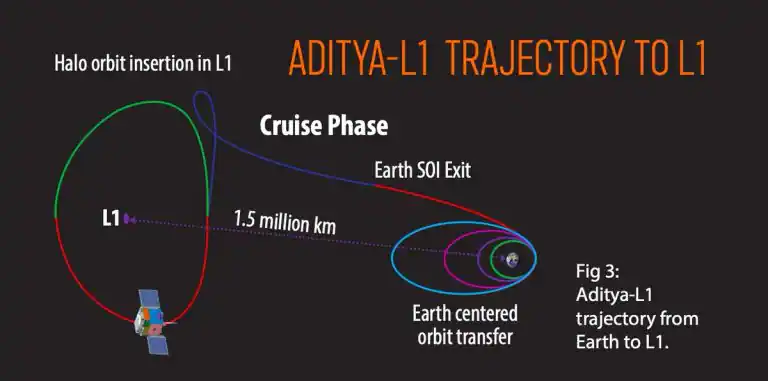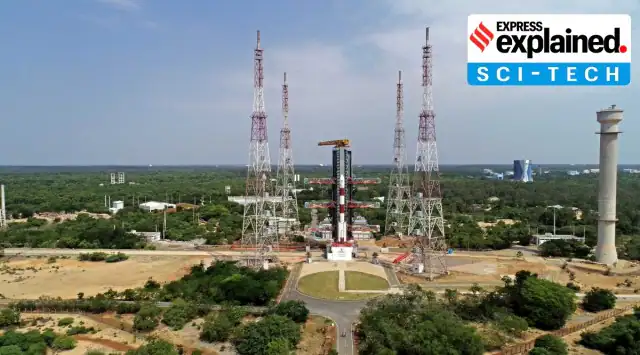
Aditya L-1 launch: How will the Aditya L-1 mission reach space? Where will it be placed in space? What are its objectives? What payloads it is carrying? And, why does ISRO need to examine the Sun anyway? Here is everything you need to know about ISRO’s Aditya-L1 mission.
The Indian Space Research Organization (ISRO) will launch Aditya L-, its first space-based mission to study the Sun, from the Satish Dhawan Space Centre in Sriharikota on Saturday (September 2) at 11:50 am. The lift-off will take place barely 10 days after ISRO became the first space agency to soft-land a spacecraft near the Moon’s south pole.
How will the Aditya L-1 mission reach space? Where will it be placed in space? What are its objectives? What payloads it is carrying? And why does ISRO need to examine the Sun anyway? Here is everything you need to know about ISRO’s Aditya-L1 mission.
How will the Aditya L-1 go into space?
The solar probe will be carried into space by the Polar Satellite Launch Vehicle (PSLV) in ‘XL’ configuration. PSLV is one of the most reliable and versatile workhorse rockets of ISRO. Previous missions likeChandrayaan-1 in 2008 and Mangalyaan in 2013 were also launched using PSLV. The rocket is most powerful in the ‘XL’ configuration as it is equipped with six extended strap-on boosters — they are larger than the boosters of other configurations and, therefore, can carry heavier payloads.
PSLV-XL can lift 1,750 kg of payloads to the sun-synchronous polar orbit (spacecraft here are synchronised to always be in the same ‘fixed’ position relative to the Sun), and much more — 3,800 kg — to a lower Earth orbit (normally located at an altitude of less than 1,000 km but could be as low as 160 km above the planet). As Aditya L-1 weighs 1,472 kg, it will be launched aboard PSLV.
Notably, Chandrayaan-3 took off aboard LVM3, the most powerful rocket of ISRO, because it was more than two times heavier than the solar probe.
What is the Aditya L-1 mission?
The PSLV will initially place the Aditya L-1 in a lower Earth orbit. Subsequently, the orbit as well as the velocity of the spacecraft around the Earth will be increased using onboard propulsion till it is slingshot towards the Sun.
The spacecraft will finally be stationed in a halo orbit around the Lagrange point 1 (L1) of the Sun-Earth system (more on this later), which is about 1.5 million km from the Earth. Named after the rising Sun, the Aditya L-1 will cover its journey to the L1 point in about four months. The spacecraft will carry seven payloads to observe solar activities for five years.
What are the objectives of the Aditya L-1?
The mission’s main objective is to expand our knowledge of the Sun, and how its radiation, heat, flow of particles, and magnetic fields affect us. Below is the list of other objectives that the mission will embark upon:
- To study the upper atmospheric layers of the Sun called chromosphere and corona. While the corona is the outermost layer, the chromosphere is just below it.
- To examine coronal mass ejections (CMEs), which are large expulsions of plasma and magnetic fields from the Sun’s corona.
- To Analyse the corona’s magnetic field and the driver of the space weather.
- To understand why the Sun’s not-so-bright corona is a million degree Celsius hot when the temperature on the surface of the Sun is just about 5,500 degrees Celsius.
- To help scientists know the reasons behind the acceleration of particles on the Sun, which leads to the solar wind — the constant flow of particles from the Sun.
What is space weather?
Space weather refers to changing environmental conditions in space. It is mainly influenced by activity on the Sun’s surface. In other words, the solar wind, magnetic field, as well as solar events like CME affect the nature of space.
“During such events, the nature of the magnetic field and charged particle environment near to the planet change. In the case of the Earth, the interaction of the Earth’s magnetic field with the field carried by CME can trigger a magnetic disturbance near the Earth. Such events can affect the functioning of space assets,” ISRO says.
What are the payloads?
There are essentially seven payloads on the Aditya L-1. The main one is the Visible Emission Line Coronagraph (VLEC) to study the solar corona from the lowermost part upwards. The Solar Ultraviolet Imaging Telescope (SUIT) will capture the UV image of the solar photosphere and chromosphere. It will examine the variation in light energy emitted.
Meanwhile, the Solar Low Energy X-ray Spectrometer (SoLEXS) and High Energy L1 Orbiting X-ray Spectrometer (HEL1OS) will Analyse X-ray flares. The Aditya Solar Wind Particle Experiment (ASPEX) and Plasma Analyser Package for Aditya (PAPA) have been built to study the solar wind and energetic ions. Read this explainer for more details.
What are the Lagrange points?
There are five Lagrange points, L1 to L5, between any two-celestial body system. At these positions, the gravitational pull of the celestial bodies equals the centripetal force required to keep a smaller third body in orbit. In simpler words, the forces acting on the third body cancel each other out.
The points can be used as ‘parking spots’ for spacecraft in space to remain in a fixed position with minimal fuel consumption, according to NASA. They have been named after Italian-French mathematician Joseph-Louis Lagrange (1736-1813), who was the first one to find the positions.
So, between the Earth and the Sun, a satellite can occupy any of five Lagrangian points. “Of the five Lagrange points, three are unstable and two are stable. The unstable Lagrange points – labelled L1, L2, and L3 – lie along the line connecting the two large masses. The stable Lagrange points – labelled L4 and L5 – form the apex of two equilateral triangles,” NASA explains. The L4 and L5 are also called Trojan points and celestial bodies like asteroids are found here.
What is a halo orbit?
NASA says a spacecraft can “orbit” about an unstable Lagrange point with a minimum use of thrusters for station keeping. Such an orbit is known as a halo orbit as “it appears as an ellipse floating over the planet”. A halo orbit, however, isn’t the usual orbit because the unstable Lagrange point doesn’t exert any attractive force on its own.
“In the Sun-Earth case for example, the spacecraft’s true orbit is around the Sun, with a period equal to Earth’s (the year). Picture a halo orbit as a controlled drift back and forth in the vicinity of the L point while orbiting the Sun,” the space agency adds.
Why study the Sun from space?
According to ISRO, the Sun “emits radiation/light in nearly all wavelengths along with various energetic particles and magnetic fields. The atmosphere of the Earth as well as its magnetic field acts as a protective shield and blocks a number of harmful wavelength radiations including particles and fields.”
This means studying the Sun from Earth can’t provide a complete picture and it becomes crucial to observations from outside the planet’s atmosphere i.e., from space.
Like us on Facebook or follow us on Twitter & Pinterest and Instagram and Keep visiting us for Latest News Online.
SOURCE: THE INDIAN EXPRESS


